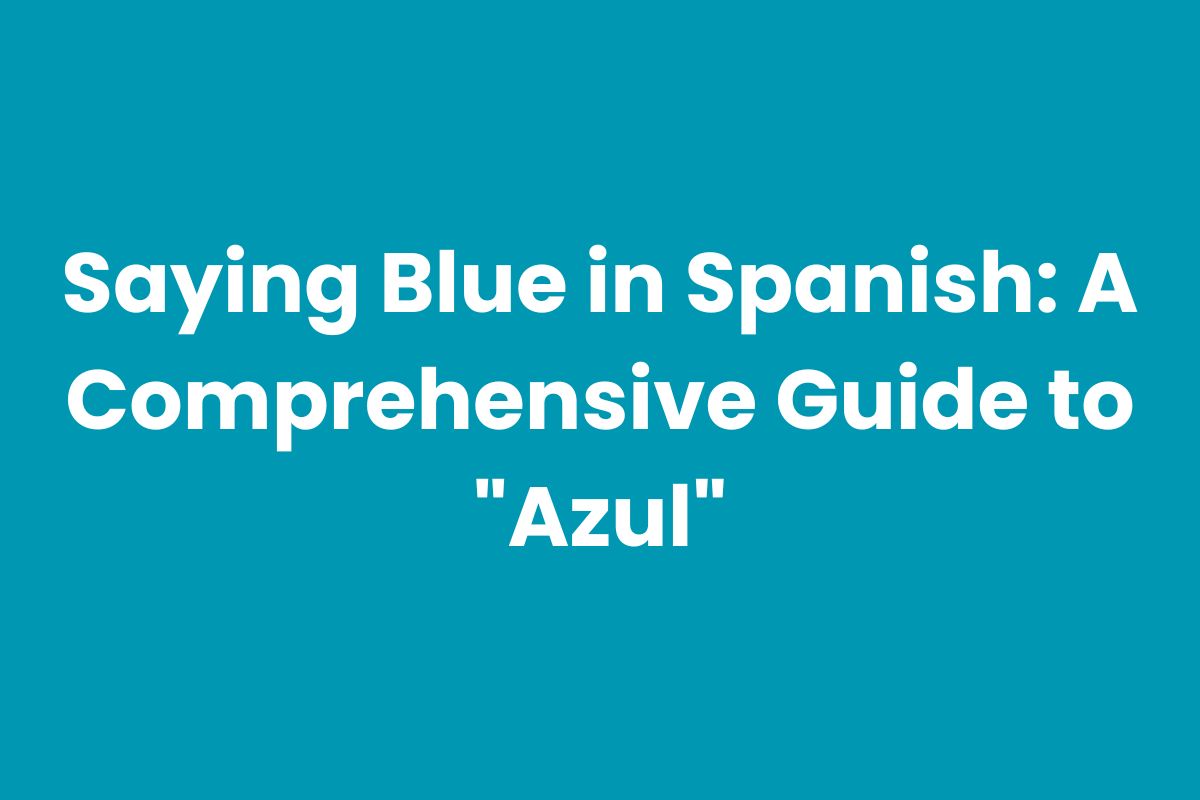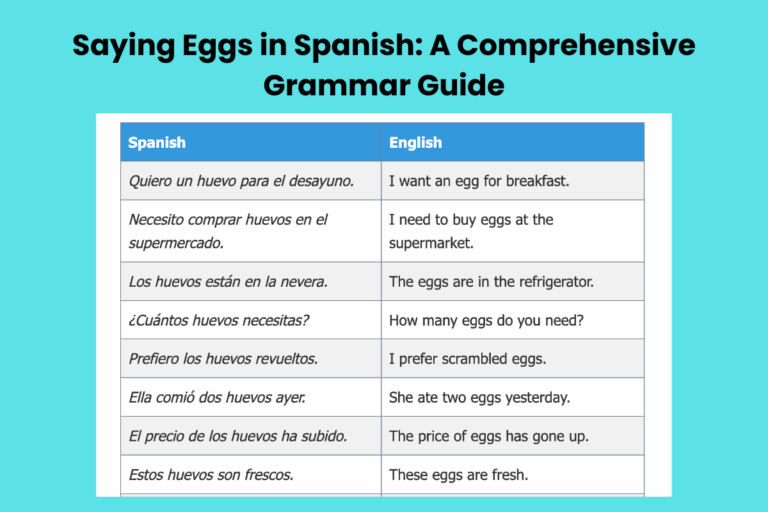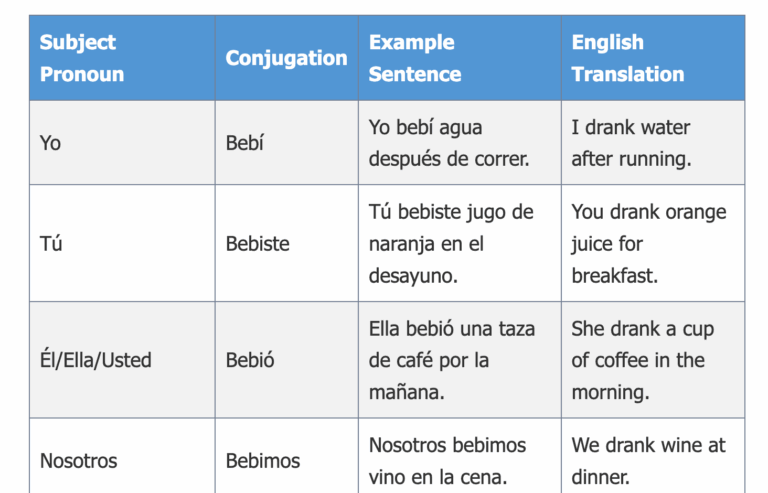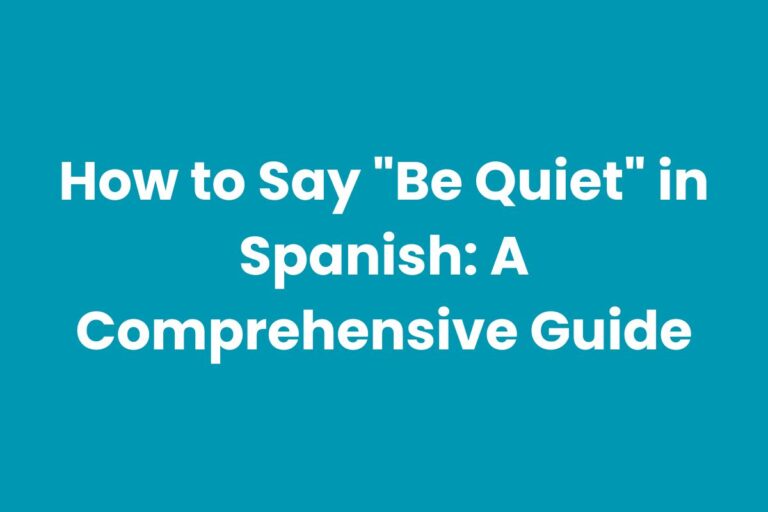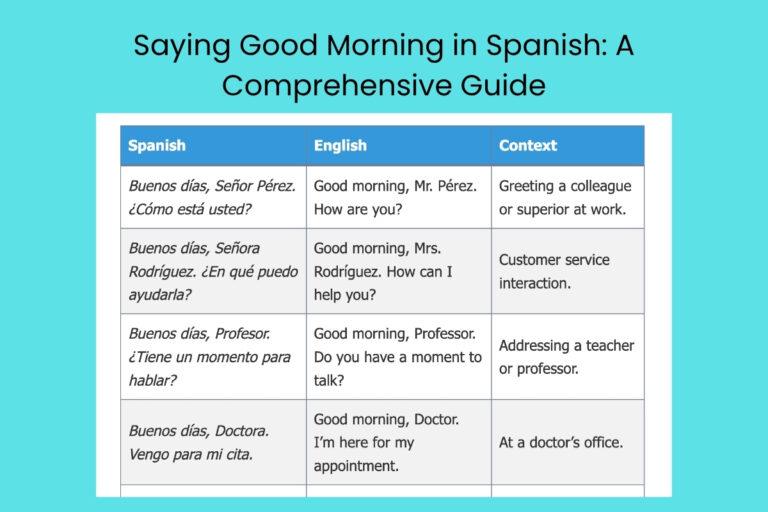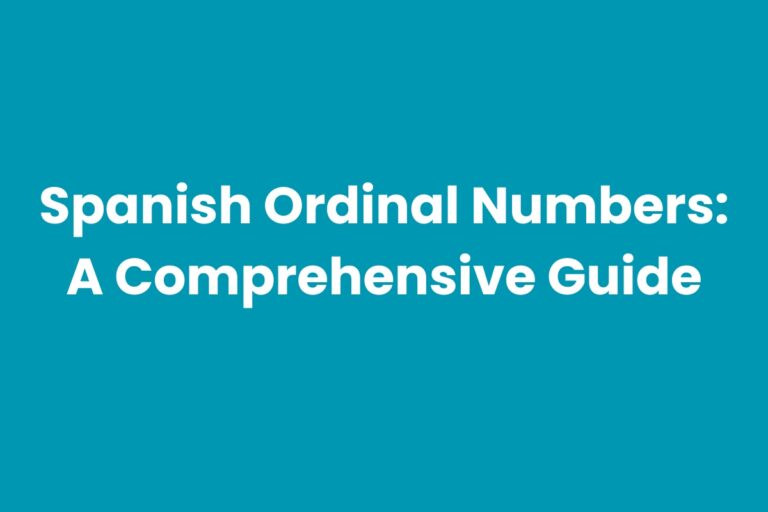Saying Blue in Spanish: A Comprehensive Guide to “Azul”
Understanding how to express colors in Spanish is crucial for effective communication, whether you’re describing a beautiful sky, a favorite piece of clothing, or a work of art. The color “blue” in Spanish, primarily translated as azul, might seem simple, but mastering its usage involves understanding grammatical agreement, nuanced vocabulary, and idiomatic expressions. This comprehensive guide is designed for learners of all levels, from beginners to advanced speakers, providing a thorough exploration of how to confidently and accurately use “azul” and related terms in Spanish.
This article will benefit anyone learning Spanish, particularly those aiming to improve their descriptive language skills. It will cover the grammatical rules governing the use of azul, explore different shades of blue and related vocabulary, and provide practical examples and exercises to solidify your knowledge. By the end of this guide, you’ll be able to confidently describe the world around you in various shades of blue, enriching your Spanish vocabulary and fluency.
Table of Contents
- Introduction
- Definition of Azul
- Structural Breakdown
- Types and Categories of Blue
- Examples of Azul in Use
- Usage Rules
- Common Mistakes
- Practice Exercises
- Advanced Topics
- FAQ
- Conclusion
Definition of Azul
Azul is the Spanish word for “blue.” It functions primarily as an adjective, describing nouns that possess the color blue. It can also function as a noun, referring to the color blue itself. Understanding this dual role is crucial for using azul correctly in different contexts. In addition to its literal meaning, azul appears in various idiomatic expressions, adding depth and nuance to its usage.
As an adjective, azul modifies nouns, indicating that they are blue in color. For example, “el cielo azul” means “the blue sky.” As a noun, azul refers to the color itself, such as in the sentence “Mi color favorito es el azul,” which translates to “My favorite color is blue.” The word is derived from Arabic, reflecting the historical influence of Arabic language and culture on Spanish.
The versatile nature of azul allows it to be used in a wide range of situations, from simple descriptions to more complex, figurative language. Whether you’re talking about the color of someone’s eyes, the ocean, or a feeling of sadness (in certain contexts), azul is a fundamental part of the Spanish vocabulary.
Structural Breakdown
The structure of azul is relatively straightforward. As an adjective, it typically follows the noun it modifies, which is a common pattern in Spanish. However, there are instances where it can precede the noun, usually for stylistic emphasis. As a noun, it is often preceded by a definite article (el or la) or used in a prepositional phrase.
Unlike some adjectives in Spanish, azul does not change its form to agree with the gender of the noun it modifies. It remains azul whether it’s describing a masculine noun (e.g., el coche azul – the blue car) or a feminine noun (e.g., la casa azul – the blue house). This simplifies its usage compared to adjectives that have different masculine and feminine forms.
Understanding the basic structure also involves recognizing how azul can be combined with other words to express different shades of blue or to create more descriptive phrases. For example, you can use adverbs like claro (light) or oscuro (dark) to specify the shade of blue, resulting in phrases like “azul claro” (light blue) and “azul oscuro” (dark blue).”
Types and Categories of Blue
Spanish, like English, has a rich vocabulary for describing different shades and variations of blue. Understanding these nuances can significantly enhance your ability to communicate effectively and express yourself more precisely.
Here’s a breakdown of some common types and categories of blue in Spanish:
Light Blue
Light blue in Spanish is commonly expressed as azul claro. This term is used to describe any shade of blue that is lighter than the standard blue. Other terms that can be used to describe light blue include celeste, which is often used to describe the color of the sky, and turquesa, which refers to turquoise blue.
Azul claro is a versatile term that can be used in a variety of contexts. It is often used to describe clothing, objects, and natural phenomena. For example, you might say “una camisa azul claro” (a light blue shirt) or “el cielo azul claro” (the light blue sky).
Dark Blue
Dark blue is typically expressed as azul oscuro in Spanish. This term is used to describe any shade of blue that is darker than the standard blue. Other terms that can be used to describe dark blue include azul marino, which refers to navy blue, and añil, which is a deep indigo blue.
Azul oscuro is often used to describe things like clothing, cars, and other objects. For example, you might say “un coche azul oscuro” (a dark blue car) or “unos pantalones azul oscuro” (dark blue pants). It can also be used in more abstract contexts, such as describing a mood or feeling.
Other Shades of Blue
Beyond light and dark blue, Spanish offers a variety of other terms to describe specific shades of blue. These include:
- Celeste: Sky blue
- Turquesa: Turquoise
- Índigo: Indigo
- Añil: A deep indigo
- Azul rey: Royal blue
Each of these terms carries its own specific connotation and is used in different contexts. For example, turquesa is often associated with tropical beaches and gemstones, while índigo is often used to describe the color of denim or traditional dyes.
Examples of Azul in Use
To fully understand how to use azul in Spanish, it’s helpful to see it in action. Here are several examples of azul used as an adjective, a noun, and in idiomatic expressions.
Azul as an Adjective
When used as an adjective, azul describes a noun. Here are some examples showcasing how azul is used to modify different nouns:
The following table provides examples of azul used as an adjective in different sentences. Note how the adjective doesn’t change based on the gender of the noun.
| Spanish Sentence | English Translation |
|---|---|
| El cielo es azul. | The sky is blue. |
| Ella tiene los ojos azules. | She has blue eyes. |
| Compré un coche azul. | I bought a blue car. |
| La casa azul es muy bonita. | The blue house is very pretty. |
| Me gusta mi camisa azul. | I like my blue shirt. |
| Los zapatos azules son nuevos. | The blue shoes are new. |
| El mar azul es profundo. | The blue sea is deep. |
| Un pájaro azul voló por la ventana. | A blue bird flew through the window. |
| La flor azul es rara. | The blue flower is rare. |
| Pintamos la pared azul. | We painted the wall blue. |
| El vestido azul es elegante. | The blue dress is elegant. |
| Quiero un bolígrafo azul. | I want a blue pen. |
| La puerta azul está cerrada. | The blue door is closed. |
| El globo azul flotaba en el aire. | The blue balloon floated in the air. |
| La bufanda azul es cálida. | The blue scarf is warm. |
| El libro azul es interesante. | The blue book is interesting. |
| Las luces azules brillan en la noche. | The blue lights shine in the night. |
| El cuadro azul es abstracto. | The blue painting is abstract. |
| La alfombra azul está en el salón. | The blue carpet is in the living room. |
| El sombrero azul me queda bien. | The blue hat suits me well. |
| Los calcetines azules son cómodos. | The blue socks are comfortable. |
| El mantel azul está limpio. | The blue tablecloth is clean. |
| La taza azul es mi favorita. | The blue mug is my favorite. |
| El cojín azul es suave. | The blue cushion is soft. |
| La toalla azul está seca. | The blue towel is dry. |
| El jarrón azul es decorativo. | The blue vase is decorative. |
| La bicicleta azul es nueva. | The blue bicycle is new. |
| El paraguas azul me protege de la lluvia. | The blue umbrella protects me from the rain. |
Azul as a Noun
When used as a noun, azul refers to the color blue itself. It often appears with a definite article (el) or in prepositional phrases.
The following table provides examples showcasing the use of azul as a noun, referring to the color itself.
| Spanish Sentence | English Translation |
|---|---|
| El azul es mi color favorito. | Blue is my favorite color. |
| Prefiero el azul al rojo. | I prefer blue to red. |
| Me gusta el azul del cielo. | I like the blue of the sky. |
| Pinté la pared de azul. | I painted the wall blue. |
| El azul representa la tranquilidad. | Blue represents tranquility. |
| En la bandera, el azul simboliza la libertad. | In the flag, blue symbolizes freedom. |
| El azul es un color frío. | Blue is a cold color. |
| Añade un toque de azul. | Add a touch of blue. |
| El azul marino es un color elegante. | Navy blue is an elegant color. |
| Me encanta el azul turquesa. | I love turquoise blue. |
| El azul es el color de la lealtad. | Blue is the color of loyalty. |
| El azul claro es relajante. | Light blue is relaxing. |
| Combina el azul con el blanco. | Combine blue with white. |
| El azul índigo es muy intenso. | Indigo blue is very intense. |
| El azul rey es un color vibrante. | Royal blue is a vibrant color. |
| Necesito más azul para pintar. | I need more blue to paint. |
| El azul se ve bien en esa habitación. | Blue looks good in that room. |
| El azul es un color popular. | Blue is a popular color. |
| El azul del océano es impresionante. | The blue of the ocean is impressive. |
| El azul y el verde combinan bien. | Blue and green combine well. |
| El azul es un color primario. | Blue is a primary color. |
| El azul puede ser calmante. | Blue can be calming. |
| El azul es asociado con el agua. | Blue is associated with water. |
| El azul está presente en muchas banderas. | Blue is present in many flags. |
| El azul es símbolo de confianza. | Blue is a symbol of trust. |
| El azul es usado en la decoración. | Blue is used in decoration. |
| El azul es un color versátil. | Blue is a versatile color. |
| El azul es esencial en la paleta de colores. | Blue is essential in the color palette. |
Idiomatic Expressions with Azul
While not as common as in some other languages, azul does appear in a few idiomatic expressions in Spanish. Understanding these expressions can add a layer of sophistication to your language skills.
The following table presents some idiomatic expressions with azul, providing their meanings and example sentences.
| Spanish Idiomatic Expression | English Translation | Example Sentence | English Translation of Example |
|---|---|---|---|
| Sangre azul | Blue blood | Dicen que tiene sangre azul. | They say he has blue blood. |
| Ponerse morado/azul | To turn purple/blue (from exertion) | Corrió tanto que se puso azul. | He ran so much that he turned blue. |
Usage Rules
Using azul correctly involves understanding a few key grammatical rules. These rules govern agreement, placement, and exceptions to ensure accurate and natural-sounding Spanish.
Grammatical Agreement
Unlike many Spanish adjectives, azul does not change its form to agree with the gender of the noun it modifies. It remains azul whether the noun is masculine or feminine. This makes it easier to use compared to adjectives that have different masculine and feminine forms.
However, azul does need to agree in number (singular or plural) with the noun it modifies. For singular nouns, use azul. For plural nouns, use azules.
Adjective Placement
In Spanish, adjectives typically follow the noun they modify. This is also true for azul. For example, you would say “el coche azul” (the blue car), not “el azul coche.”
However, there are instances where the adjective can precede the noun for stylistic emphasis or to convey a subjective quality. In these cases, the meaning of the sentence can subtly change. For example, “un azul cielo” (a blue sky) emphasizes the blueness of the sky more than “un cielo azul.” This placement is less common with azul compared to other descriptive adjectives.
Exceptions and Special Cases
While azul generally follows the standard rules for adjective usage, there are a few exceptions and special cases to be aware of:
- Compound Colors: When describing compound colors (e.g., blue-green), the word azul is often combined with other color words using the conjunction y (and). For example, “azul y verde” (blue and green).
- Idiomatic Expressions: As mentioned earlier, idiomatic expressions may have unique usage patterns that deviate from the standard rules. It’s important to learn these expressions as fixed phrases.
Common Mistakes
Learners often make certain common mistakes when using azul. Being aware of these mistakes can help you avoid them and improve your accuracy.
The following table highlights some common mistakes and provides the correct alternatives.
| Incorrect | Correct | Explanation |
|---|---|---|
| El azul coche | El coche azul | Adjective placement: Adjectives usually follow the noun in Spanish. |
| Las casas azul | Las casas azules | Number agreement: Adjectives must agree in number with the noun. |
| El cielo es azuls | El cielo es azul | The word “azul” is already in its correct form. |
| Yo tengo un ojos azul | Yo tengo unos ojos azules | Incorrect article and number agreement. |
Practice Exercises
To solidify your understanding of azul, try these practice exercises. Fill in the blanks with the correct form of azul.
Exercise 1: Fill in the Blanks
Complete the following sentences with the correct form of “azul”:
| Question | Answer |
|---|---|
| 1. El mar es ______. | azul |
| 2. Los globos son ______. | azules |
| 3. Ella tiene un vestido ______. | azul |
| 4. Mis zapatos favoritos son ______. | azules |
| 5. El cielo está ______ hoy. | azul |
| 6. Las flores ______ son raras. | azules |
| 7. Compré un coche ______. | azul |
| 8. Las camisas ______ están en oferta. | azules |
| 9. El color de mis ojos es ______. | azul |
| 10. Las plumas ______ son de un pájaro exótico. | azules |
Exercise 2: Translate the Sentences
Translate the following sentences into Spanish using “azul”:
| English Sentence | Spanish Translation |
|---|---|
| 1. The blue car is fast. | El coche azul es rápido. |
| 2. I like blue shoes. | Me gustan los zapatos azules. |
| 3. The sky is blue today. | El cielo está azul hoy. |
| 4. She has a blue dress. | Ella tiene un vestido azul. |
| 5. Blue is my favorite color. | El azul es mi color favorito. |
| 6. The blue flowers are beautiful. | Las flores azules son hermosas. |
| 7. He painted the wall blue. | Él pintó la pared azul. |
| 8. The blue house is big. | La casa azul es grande. |
| 9. They have blue eyes. | Ellos tienen ojos azules. |
| 10. The blue sea is calm. | El mar azul está tranquilo. |
Advanced Topics
For advanced learners, understanding the cultural and symbolic significance of colors, as well as regional variations in language, can add depth to your knowledge.
Color Symbolism
In many cultures, colors carry symbolic meanings. In Western cultures, blue is often associated with calmness, peace, and stability.
In some Latin American cultures, blue can also symbolize trust and loyalty. Understanding these cultural associations can help you interpret literature, art, and social customs more effectively.
Regional Variations
While azul is the standard word for “blue” in Spanish, there may be slight regional variations in how it is used or in the specific shades of blue that are commonly described. For example, the term celeste might be more prevalent in certain regions to describe sky blue. Being aware of these variations can help you better understand and communicate with speakers from different Spanish-speaking countries.
FAQ
Here are some frequently asked questions about using azul in Spanish:
- Is azul masculine or feminine?
Azul does not change based on gender. It is used with both masculine and feminine nouns. - How do I say “light blue” in Spanish?
“Light blue” is typically translated as azul claro. - How do I say “dark blue” in Spanish?
“Dark blue” is typically translated as azul oscuro. - Does azul change in the plural form?
Yes, the plural form of azul is azules. - Can I put azul before the noun?
While it’s more common to place it after the noun, you can put it before for emphasis, though this is less frequent. - Are there any synonyms for azul?
While azul is the standard term, other words like celeste (sky blue) and turquesa (turquoise) can be used to describe specific shades of blue. - How is azul used in idiomatic expressions?
Azul appears in a few idiomatic expressions, such as “sangre azul” (blue blood), referring to nobility. - What does blue symbolize in Spanish-speaking cultures?
Blue often symbolizes calmness, trust, and loyalty, similar to its symbolism in Western cultures. - Is there a difference between azul and celeste?
Yes, celeste specifically refers to sky blue, while azul is a more general term for blue. - How do I say “blue and green” in Spanish?
You would say “azul y verde.”
Conclusion
Mastering the use of azul in Spanish is a fundamental step towards fluency and effective communication. By understanding its grammatical function, its variations in shades, and its usage in idiomatic expressions, you can confidently describe the world around you in a more nuanced and accurate way. Remember that azul is a versatile word that can be used in a wide range of contexts, from simple descriptions to more complex, figurative language.
Continue practicing with the examples and exercises provided in this guide, and don’t be afraid to experiment with different shades and expressions. Pay attention to how native speakers use azul in their everyday conversations and writing. With consistent effort and attention to detail, you’ll be well on your way to mastering the art of saying “blue” in Spanish and enriching your overall language skills. Good luck, and happy learning!

